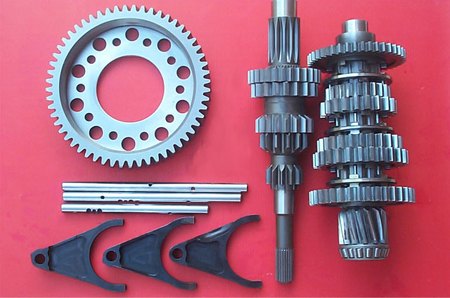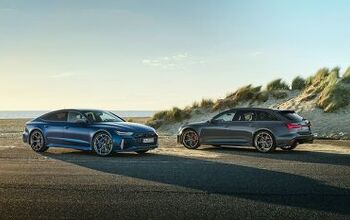177 Views
Ask the Best and Brightest: Dog Engagement Vs. Synchromesh

by
Stewart Dean
(IC: employee)
Published: January 10th, 2009
Share
This subject came up in the comments underneath my review of the Bugatti T40. [If you haven’t come across dogboxes before, they’re explained (or at least chewed over) here.] Googling to shed some light on the debate, I came across this hair-raising video of BMW supercar with a straightcut dogbox eating up the competition, sounding like something out of Star Wars. My take is that while straight cut spur gear are weaker (in principle), they can be constructed to be enough bigger in the same space that they end up stronger (in practice). Perhaps TTAC’s Best and Brightest would care to comment?

Stewart Dean
More by Stewart Dean
Published January 10th, 2009 9:35 AM































Comments
Join the conversation
Cool video. I'll keep my synchronized h-pattern transmission with helical gears for street use though.
Thanks all, the Best and Brightest have it covered. It seems that in any modern, moderate load application helical synchro is the no-brainer choice, that in a few high-stress, high-load situations, dump trucks and wild-ass race cars, straight-cut can be built stronger and are the ultimate solutions. The Bugattis' gear noise was never in the dentist-drill frequency range exhibited by that Dutch Uber-Bimmer. Unless that driver is Old Nick or has some incredible hearing protection, his hearing is going to last as long as the gearbox: one season at best.
I think there are a few misconceptions in the above posts. Straight-cut gears vs. helical - The whole point of helical gears is to intentionally create a thrust load (along the axis of the shaft's rotation) to force the gears into engagement and thus decrease noise. The drawback is that this thrust force puts a hell of a load on the case, and can actually lead to failure of the case or endplates. Thus, straight-cut gears are stronger, but the amount of noise is pretty much unacceptable for street use. What you'll see in heavy-duty transmissions (like the later versions of the Tremec T56) is that the lower gear ratios have a lower engagement angle (not quite straight-cut, but getting close) to get some more strength where it's usually needed. The upper ratios go with a larger angle to decrease noise when cruising. Dog-cut vs. synchros - Both types of gearbox use the constant-mesh principle, so we're not banging the actual gear teeth in and out of engagement. Rather, the difference is in how we lock those gears to the shaft. A synchro uses some friction material to match the speed between the shaft and the gear that's being selected. This friction material may be organic in lower-perf boxes, and carbon in higher-end boxes - it's a trade-off between performance when the box is dead-cold on a winter morning, and after a few hard laps at the track or passes down the strip. Once the friction material gets everything spinning at the same speed, a series of small teeth are aligned and mate to transmit the torque. Dog boxes don't use any friction material, and depend on the mechanical engagement of large blocks of material (the "dogs"). The "dogs" in a dogbox are typically much bigger and stronger than the teeth in a synchro box, so the dogbox is usually more durable. These larger teeth are also typically spaced as to allow greater misalignment prior to engagement, reducing the chance that the transmission prevents the driver from executing a gear change. The dogbox also demands a rather forceful touch (some also require the driver to properly match revs), and thus can be wiped out quickly by someone who doesn't know what he is doing. It's possible to mix-and-match the above technologies, but in practice this is rarely done. If you're going after such an all-out effort that you choose dog engagement or straightcut gears, then you'll probably pick both. This isn't a hard-and-fast rule, though; for example, you can find aftermarket vendors that will dog-cut your production gearbox to eliminate the synchros but leave the helical-cut gears in place. Note that most motorcycle transmissions are dog-cut and use straight (or very nearly straight) teeth.
All modern automotive manual and robotised manual gearboxes are constant mesh with only Reverse being the exception. Premium cars with manual trannies may offer a constant mesh reverse as well, complete with synchronizer. Most, however, employ a sliding idle pinion solution. Which is why the gears involved in reversing also have to have a straight cut tooth profile leading to that characteristic whine. To permit the sliding in and out of engagement of the idler gear without lateral thrust on it. Except for lateral thrust, helical profile gears are superior in every respect to spur gears, including torque limits. The proper, elegant engineering solution to the side thrust issue is to employ double helical/chevron gears to cancel it out. Unsurprisingly, it was the hallmark of French auto maker Citroën. Because the French have always been in the bad habit of actually engineering solutions instead of hacking stuff together like the Germans. But I digress. The drawback, there was bound to be one, is that chevron gears are very unsuitable to mass production. They are damn near impossible to machine without welding two helical gears together or leaving a flat ring round the middle of the gear. Leaving the flat ring in the middle makes the gears wider than they could be. They are used in very high power/industrial applications. Of course, the corner cutting approach is to just use spur gears and rebuild/replace the box each season.